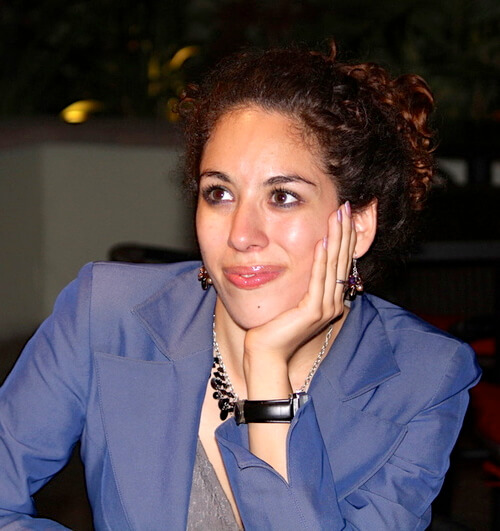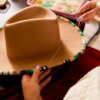When I started reading Christine Stoddard’s Belladonna Magic, I felt as if I was being thrust into a deep part of womanhood that I had considered in slices without investigating all the angles and depth that exist to it. The poetry contained in Belladonna Magic are emotive, full and bursting at the seams while at the same time singling out thoughts to lend intense, microscopic look at them. Christine really pulled my emotional muscles with this collection.
Christine Sloan Stoddard is a Salvadoran-Scottish-American writer and artist who lives in Brooklyn. She is the founding editor of Quail Bell Magazine, an art and culture magazine. She is also the author of Naomi and the Reckoning, Jaguar in the Cotton Field, Hispanic & Latino Heritage in Virginia. It is such a gem to behold her work and speak to her on her process for creating Belladonna Magic.
For Creative Girls: Your use of metaphors to describe the woman’s body is so intense and visual! What led to you writing this body of work?
I grew up with two sisters and a mother who came from El Salvador, where women’s rights are still very limited in many ways. Women there can be charged with murder for not only abortion but miscarriage and stillbirth, as well. Child marriage, teen pregnancy, femicide, girls’ education, human trafficking, and barriers to financial independence are other major issues for girls and women in El Salvador. From a young age, I was taught to be independent and resourceful, so I have always identified with feminism.
Of course, you can take the monkey out of the jungle but you can’t take the jungle out of the monkey. True rebellion, not just reform, is difficult in practice. Even with my mother’s desire to leave much of her homeland’s culture behind, she raised my sisters and me with some very traditional ideas about the body and sexuality. I had to discover a lot of that stuff on my own, which unfortunately involved a lot of shame. I think the intensity of my writings about the body comes from a place of both desperation and stubbornness. Women should not feel ashamed for being human. I wrote this body of work inspired by this belief. The visuals were strongly influenced by the aesthetic I’ve developed as the founding editor of Quail Bell Magazine.
I’ve always found that poetry can be a bit heavy on the mind, but you’ve been able to cut into a space of balance where the heaviness isn’t bothering on being difficult to understand. What do you think has influenced your style of writing and balance?
I strove to balance feathers and stones in Belladonna Magic. The focus on the narrative and confessional stemmed from my desire to communicate that vulnerability is the starting point for magic. First, we as women have to recognize what we want to change before we can change it. This requires humility, honesty, and reflection as much as it does strength. Such a step is necessary for any human, but I emphasize women because I am one. I know firsthand what it feels like not to have enough—or any—agency in a situation. This is a collection geared toward women for inspiration and empowerment, even if some of the experiences mentioned are painful and raw. It’s during those down times that we have to muster the most magic.
I wanted the stories and images—both literary and the actual photographs—in Belladonna Magic to live inside the reader. Your most vivid memory of a book shouldn’t be that of you constantly turning to the dictionary. Plenty of writers have shown how it is possible to convey strong stories and ideas through simple language. For me, it also was critical to include images in Belladonna Magic—not to break up the words, but to complement them. The poems are meant to open up the reader’s heart and mind to possibilities. The images are meant to further expand the reader’s thinking of what those possibilities could be.
You also talk about being pregnant and giving birth and how that has changed your body, life, and perspective. Can we dwell on that aspect for a bit? Shed more light on that process and how it made you evolve into who you are now.
I want to be clear that this collection is not strictly true-to-life or autobiographical. Some of the narrators are me—to an extent—and others are not. Perhaps they are more heavily fictionalized versions of me or versions of other women in my life. Some of the narrators come entirely from my imagination. This is poetry, not journalism, so I am not so concerned with the facts. I care much more about the reality of emotions and experiences that make up diverse women’s lives as part of the human condition.
Though I’m not interested in disclosing details of my personal life in relation to Belladonna Magic, I will say this much: I have never been pregnant and I am not a mother, biological or adoptive. While I am happily married and hope to have a child one day, I cannot speak from firsthand experience as a mother. But as an artist, I do have empathy. I have spent a lot of time listening to mothers and observing mothers and reading about mothers. I have spent a lot of time putting myself in their place and imagining my potential future as a mother. I have spent a lot of time working with children as a teaching artist, artist-in-residence, and former AmeriCorps volunteer. I understand, very rationally, how motherhood must change a woman in a way that society does not allow, or force, fatherhood to change a man. I have some emotional understanding, but it will take actually becoming a mother for me to fully understand.
“Garlic Eater” is a bit tricky to put the finger on. What does “Garlic Eater” portray for you?
This poem could touch on hook-up culture, sex work, or more generally sex lacking intimacy, depending upon your reading. The narrator is tired of partners who do not respect her, but she is hopeful that feelings of low self-worth will not linger. She knows she matters, even if other people may forget that sometimes.
“Mary in Wyoming,” “The Cruelty of Ants,” “A Unity Poem for Women,” and “Lady Minnow” are so poignant! Do these poems convey societal manipulations that you wanted to bare in the open?
Definitely. Too often our feelings of guilt and inadequacy as women are borne from society’s flaws, not our own.
I really love the “Snail’s Way” personally – a depiction of I think ideas, concepts, and life should sometimes be seen.
Thank you. It reminds me of something my ceramic sculpture professor at The City College of New York once said: Most artists aren’t wild and crazy; they’re disciplined.
They do the hard work. I’m learning to appreciate peace, quiet, patience, and concentration more and more. I wish our society valued those things more, too.
Belladonna Magic makes me want to question a lot of things about the universe. Did you write it like that on purpose? Or did it just flow out of you and you realized that this was what you had birthed?
I hope that everything I make encourages my reader to think, question, and reimagine. That is the same philosophy I have for the world I’ve created with fellow editors at Quail Bell Magazine. In that respect, Belladonna Magic wasn’t any different than other projects of mine. I actually wrote it while I was the artist-in-residence at Annmarie Sculpture Garden, a Smithsonian affiliate in Maryland. At that time, I designed and implemented a public art project called Chesapeake Menagerie to get visitors thinking about the environment and wildlife in the Chesapeake Bay region. I used locally sourced recycled materials to create 11 large-scale sculptures. My favorite sculpture was a crab, which also happens to be a state symbol for Maryland and a scavenger in the wild. Visitor after visitor told me they had never considered using bottlecaps or broken Christmas lights or orphan Legos for sculpture. Many of them weren’t aware of local environmental issues or how Capitalism made them complicit in destroying the natural beauty of where they lived. This was in an area where many people stayed their whole lives.
Art is a process and you often don’t know what the final result will be until a project is finished. Chesapeake Menagerie and Belladonna Magic have that in common—creating them was a process and, though I had a vision, the final outcome challenged (and exceeded) my expectations.
Get Belladonna Magic here and get to know more about Christine here.







